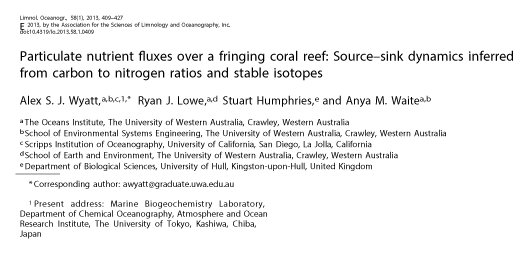Particulate nutrient fluxes over a fringing coral reef: Source-sink dynamics inferred from carbon to nitrogen ratios and stable isotopes
Alex S. J. Wyatt, Ryan J. Lowe, Stuart Humphries and Anya M. Waite
We examined spatial and temporal variations in particulate organic matter (POM) dynamics over a fringing coral reef (Ningaloo Reef) in Western Australia during the austral autumn and spring. Total POM concentrations generally did not differ between seasons or reef zones, but the composition of POM, in terms of carbon isotope ratios (δ13C-POM), carbon to nitrogen ratios (C : N), and fatty acids, changed consistently in water flowing across the reef. Both δ13C-POM and C : N increased from the fore reef to the reef flat and lagoon, −23.0‰ to −20.1‰ and 7.31 to 8.34, respectively. Average rates of net POM uptake by the reef community were highest over the reef crest (4 to 30 mmol N m−2 d−1 and 6 to 130 mmol C m−2 d−1), with a Bayesian isotope model confirming independent measurements of high uptake rates of allochthonous POM (oceanic phyto- and zooplankton). In contrast, over the reef flat, net release of POM was observed (−4 to −5 mmol N m−2 d−1 and −50 mmol C m−2 d−1), with gross release rates (estimated as −6 to −8 mmol N m−2 d−1 and −30 to −90 mmol C m−2 d−1) indicating that the release of autochthonous POM may be of similar magnitude to allochthonous uptake. Examining POM dynamics in terms of gross fluxes reinforces the dependence of coral reef systems on oceanographic processes for allochthonous POM supply, as well as highlighting the potential for autochthonous POM production to supply nutrients to benthic and pelagic communities downstream.

